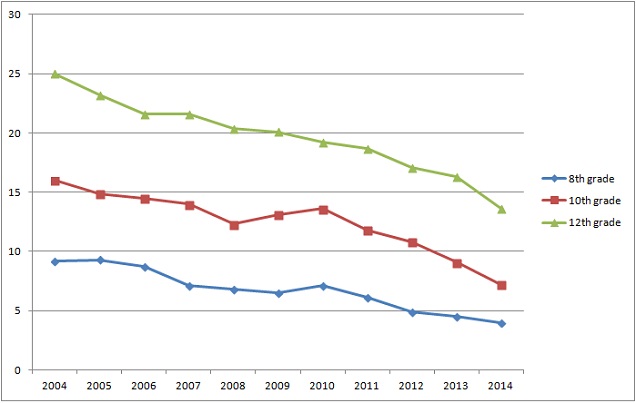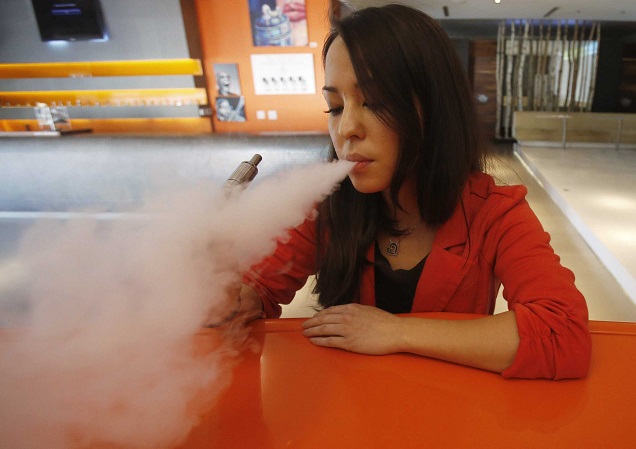
The story that won’t die is back for another round with the new Monitoring the Future 2014 results, which show that more 8th, 10th and 12th graders had used an e-cigarette in the past 30 days than had smoked a cigarette. The data seems to be taking a superficially concerning turn in this respect, indicating that e-cigarettes are actually more popular with youth than tobacco cigarettes. However, as is always the case with such research, the rates of use among non-smokers is very low, and the survey joins pretty much every other piece of research on the topic in failing to find out about daily use and whether or not nicotine was present in the e-cigs used. Additionally, the apparent rise in youth vaping has been accompanied with a substantial decline in cigarette smoking, a trend also observed in other recent research into the issue. So, are the results genuinely something to be concerned about or more overblown nonsense?
Summary
- The Monitoring the Future Survey asked over 41,500 students about drug, alcohol and cigarette use, and this year asked about e-cigarettes for the first time.
- Only past 30 day use (not daily use or weekly use) was identified, making it impossible to determine how many were regular vapers.
- More 8th, 10th and 12th graders had vaped in the past 30 days than had smoked. For 8th graders, 9 percent had vaped vs. 4 percent who’d smoked, for 10th grade it was 16.2 vs. 7.2 percent, and for 12th grade it was 17.1 vs. 13.6 percent.
- As vaping increased, the smoking rates for all grades decreased notably, overall reaching their lowest rate in the survey’s history.
- Only between 4 and 7 percent of past-month vapers were never-smokers.
- Other data suggests that only around one in nine youth past month vapers are daily e-cig users, so the daily vaping rates in these students are likely still lower than daily smoking rates, but the survey didn’t ask the required question to say this with certainty.
The Survey – Investigating Drugs, Alcohol and Tobacco Use Among Youth
The Monitoring the Future (MTF) Survey has been running since 1975, and tracks drug, alcohol and cigarette use (as well as related attitudes) among a nationally-representative sample, originally starting with 12th graders but adding 8th and 10th graders from 1991 onwards. The 2014 survey covered 377 public and private schools and ended up with a sample of 41,551 students. This is the first time the survey has asked about e-cigarette use, and it only included past 30 day use as a time-frame, despite having considerably more detailed questions about frequency of smoking. This may be better than simply focusing on ever-use, but still misses the truly crucial question about daily or even past-week use that would give a more genuine impression of regular users. In addition, it asked students questions about their perception of the risk associated with vaping.
What They Found – E-Cigarettes Use Rises as Smoking Declines
The headline finding from the e-cigarette portion of the survey is that more students had vaped in the past month than had smoked, across all of the studied grades. For 8th graders, 8.7 percent had used an e-cig in the past month, for 10th graders the corresponding figure was 16.2 percent and for 12th graders it was 17.1 percent. For cigarettes in 2014, the corresponding figures were 4 percent (8th grade), 7.2 percent (10th grade) and 13.6 percent (12th grade). This means that e-cig use was over twice as common in 8th and 10th graders, and around 26 percent more common in 12th graders. Cue panic and concern…
Principal investigator Lloyd D. Johnston answers the call: “It would be a tragedy if this product undid some of the great progress made to date in reducing cigarette smoking by teens.”
The big issue with this statement is that there is no evidence that it’s going to “undo” the progress made to date with youth smoking, and in fact the substantial decline in smoking seen in comparison to past years suggests that e-cigarettes are actually helping to reduce youth smoking. In 2013, past 30 day smoking was at 4.5 percent for 8th graders (decreased to 4.0 percent in 2014), 9.1 percent for 10th graders (now down to 7.2 percent) and 16.3 percent for 12th graders (now down to 13.6 percent). This is the biggest decrease in past-month smoking seen since 2002 for 10th and 12th graders (although 8th graders have seen larger declines more recently), and overall, youth smoking is at its lowest rate in the history of the survey. The decline from 2010, when e-cigarettes were starting to gain popularity, is particularly noteworthy.

There is also much more detailed information about the frequency of smoking than there is with e-cigarettes, and this makes for interesting reading, possibly giving insight into how many of those who tried vaping may have gone on to regular use. The gulf between past 30 day use and daily use is a notable one, with under half of the 10th and 12th graders who’d smoked in the past 30 days being daily smokers, and closer to a third for 8th graders. Additionally, only between 30 and 40 percent of ever-smokers had smoked in the past 30 days.
E-cigarettes are a new product, and it could well be that many of these past 30 day users were just trying them out of curiosity, so it’s entirely possible that less than half progressed to daily use. Addressing this point, Michael Siegel points to other data, a study in which past month e-cigarette use was at 18 percent, but just 2 percent were daily vapers (although he slightly unfairly compares ever-use with daily use). If this study is anything to go on, you can estimate that just under 1 percent of 8th graders, 1.8 percent of 10th graders and 1.9 percent of 12th graders are daily vapers from the MTF data.
Although this is obviously a crude estimate, it gets the point across pretty clearly: we don’t know much about the rates of daily or even weekly vaping among youth, which should be the primary concern, and the evidence we do have suggests that rates of daily vaping will still be very low. Additionally, these are all lower than the daily smoking rates from the MTF study, but we can’t actually say for definite because they didn’t even bother to ask about it. And they didn’t bother to ask about whether they vaped nicotine or non-nicotine e-liquids either, but still talk about a potential “gateway” to cigarette smoking in their press release.
Are E-Cigarettes a Gateway to Smoking?
There is data on the number of students who’ve tried vaping who were never smokers, and as usual the proportions are very small indeed. Three separate tables look at vaping in the past 30 days with respect to lifetime smoking for grades 8, 10 and 12, showing that just 4.1 percent of 8th graders, 7 percent of tenth graders and 4.3 percent of 12th graders who’d vaped in the past 30 days had never smoked.
This shows, yet again, that the vast majority of vapers are smokers or ex-smokers (who’ve potentially stopped due to vaping), and shows just how rare the very first step in the hypothesized “gateway” progression (start using nicotine through e-cigarettes and move on to smoking) is. If hardly any non-smokers have even tried vaping in the past 30 days (which is probably just recent one-off experimentation anyway), the gateway hypothesis is almost dead in the water before you even consider how many go on to smoke.
Also, as other research has shown, there is a correlation between being less likely to say you definitely won’t smoke (as a never-smoker) and trying an e-cigarette. This could go in either direction (the slight curiosity about smoking coming before vaping or emerging afterwards), but it’s reasonable to assume that this means that those never-smokers who try vaping were interested in smoking anyway. Looked at in this way, e-cigarettes might be giving another option to teens who would have otherwise tried smoking a cigarette, and it’s hard to see that as anything but positive.
Conclusion – When Youth Smoking is Down, Youth Vaping is a Good Thing
Getting uppity about some teenagers trying out a new smoking-like technology doesn’t really make sense if that technology is likely to be contributing to huge declines in the smoking rate. It may be superficially worrying that the youth vaping rate is higher than the youth smoking rate, but if anything this should be the goal of anti-smoking groups. We need to have the hard-won wisdom to say, “We can’t completely stop teenagers wanting to try out smoking, but if we can shift that experimentation onto something much safer, it’s a victory for public health.” Even if the majority of the e-cig users found in this survey weren’t probably just trying it out once (and if we actually knew how many regular users there were), health groups should be happy about the impact vaping is having on youth smoking rates. But they’re so ingrained in this misguided fight to stamp out all forms of nicotine use they either ignorantly don’t see it or purposefully ignore it.


